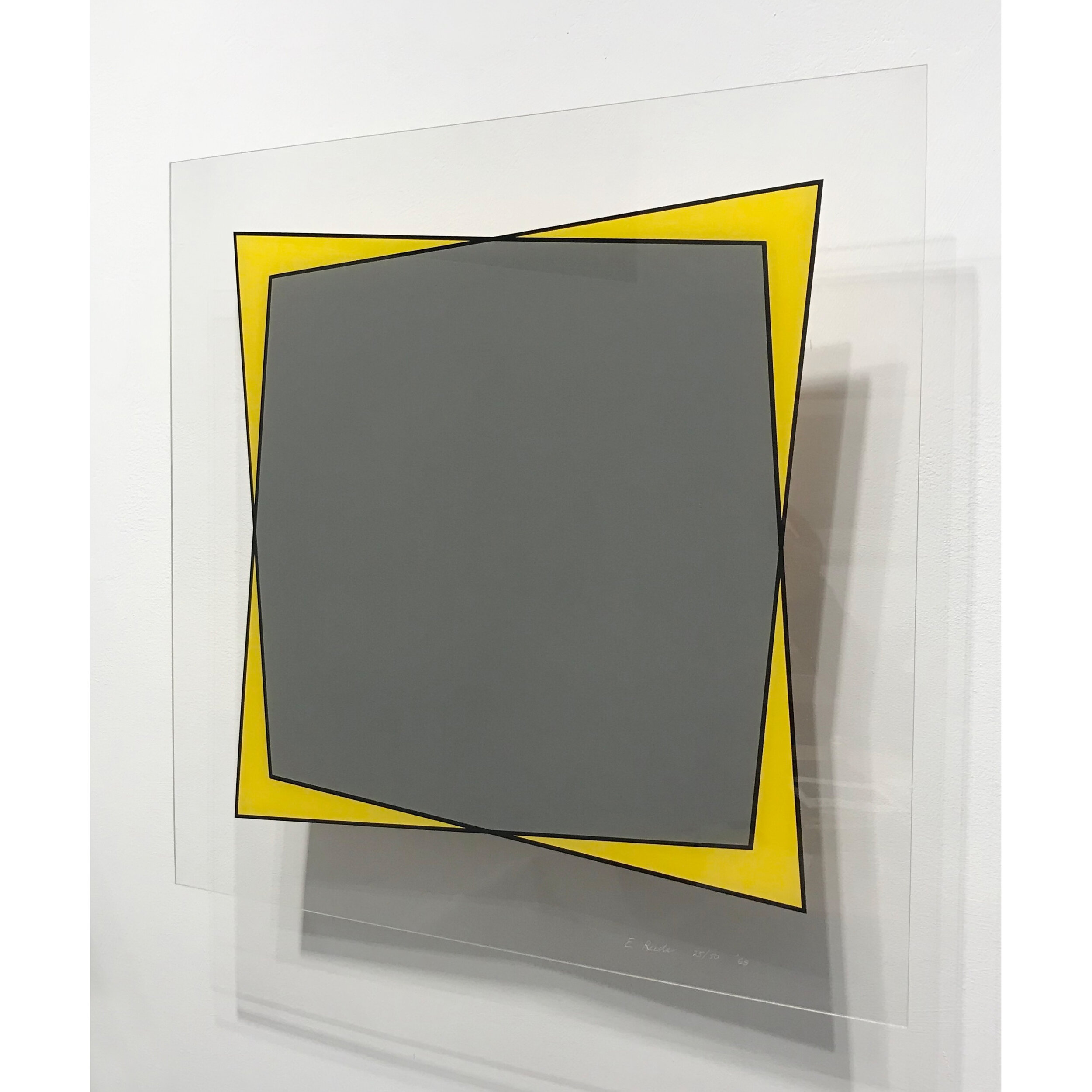Edwin Ruda, Untitled, 1968
Paint on plexiglass, matboard and wooden cradle mount
23 x 23 x 2.75 inches
Edition: 25/50
Biography
Edwin Ruda (1922-2014) was born in New York City in 1922 and grew up in the East Bronx. The artist graduated from Cornell University in 1947, having interrupted his studies to enlist in the navy during World War II. In 1949 he received a Master of Arts from Columbia University and spent the following decade studying in Mexico City, teaching at the University of Texas, and completing a Master of Fine Arts at University of Illinois, Urbana-Champaign.
Unafraid to step beyond stylistic boundaries, Edwin Ruda consistently probed the incongruities and connections between minimalism and the geometric and lyrical modes of abstraction. Ruda’s “band” paintings embody his efforts to reconcile these two divergent forms. The result is an elegant, radiant body of work. Loosening the flow of his paint, Ruda introduced pure and translucent bands of colors that are rarely part of minimalist statements. He then worked through the resulting contradictions without allowing structure or formlessness to dominate.
Ruda returned to New York in the early 1960s. By 1962 he had introduced hard-edged shapes into his art, creating arrangements with strong geometric and optical properties. During the mid-1960s he became a leading figure in the Park Place Group, the model for the activist and cooperative galleries that followed. The Group included artists such as Mark di Suvero, Forrest Myers, and Leo Valledor. Ruda’s style started loosening, evolving ultimately into the “band” paintings.
Ruda’s work is in numerous public collections, including the Aldrich Museum of Contemporary Art, Ridgefield, Connecticut; the Allentown Art Museum, Pennsylvania; the National Gallery of Australia, Canberra; the Corcoran Gallery of Art, Washington, D.C.; the Dallas Museum of Art, Texas; the Empire State Plaza Art Collection, Albany, New York; the Herbert F. Johnson Museum, Cornell University, Ithaca, New York; the High Museum of Art, Atlanta, Georgia; the Jack S. Blanton Museum of Art, University of Texas, Austin; the Indianapolis Museum of Art; the Katonah Art Center, New York; the Lannan Foundation, Santa Fe, New Mexico; the Museum of Fine Arts, Houston, Texas; the Speed Art Museum, Louisville, Kentucky; the Udine Museum of Art, Italy (collective gift organized by Thomas Hess); the University of Massachusetts, Amherst; the Weatherspoon Art Gallery, Greensboro, North Carolina; and the William Benton Museum of Art, Storrs, Connecticut.
Peter Schjeldahl stated in 1973 that Ruda, “a painter of large, complex painterly abstractions,” was “an artist often overlooked in discussions of contemporary painting, but I believe one of the finest in America.” James Gleeson wrote in a 1974 review of Ruda’s show at Gallery A, Sydney, Australia, that the artist had found the “missing link between minimal art and lyric abstraction.”
From the 1960s through the 1990s, Ruda’s art was featured in many of the most significant exhibitions of American abstraction, including Systemic Painting, at the Guggenheim Museum (1966); Cool Art, at the Aldrich Museum, Ridgefield, Connecticut (1968); two Whitney Museum biennials (1969 and 1973); and many others. From the late 1960s through the mid-1970s, he showed at the new gallery established by Paula Cooper on Prince Street in Soho.
Ruda died on February 25, 2014 at age 91.
(Biography courtesy of Artlyst)
Paint on plexiglass, matboard and wooden cradle mount
23 x 23 x 2.75 inches
Edition: 25/50
Biography
Edwin Ruda (1922-2014) was born in New York City in 1922 and grew up in the East Bronx. The artist graduated from Cornell University in 1947, having interrupted his studies to enlist in the navy during World War II. In 1949 he received a Master of Arts from Columbia University and spent the following decade studying in Mexico City, teaching at the University of Texas, and completing a Master of Fine Arts at University of Illinois, Urbana-Champaign.
Unafraid to step beyond stylistic boundaries, Edwin Ruda consistently probed the incongruities and connections between minimalism and the geometric and lyrical modes of abstraction. Ruda’s “band” paintings embody his efforts to reconcile these two divergent forms. The result is an elegant, radiant body of work. Loosening the flow of his paint, Ruda introduced pure and translucent bands of colors that are rarely part of minimalist statements. He then worked through the resulting contradictions without allowing structure or formlessness to dominate.
Ruda returned to New York in the early 1960s. By 1962 he had introduced hard-edged shapes into his art, creating arrangements with strong geometric and optical properties. During the mid-1960s he became a leading figure in the Park Place Group, the model for the activist and cooperative galleries that followed. The Group included artists such as Mark di Suvero, Forrest Myers, and Leo Valledor. Ruda’s style started loosening, evolving ultimately into the “band” paintings.
Ruda’s work is in numerous public collections, including the Aldrich Museum of Contemporary Art, Ridgefield, Connecticut; the Allentown Art Museum, Pennsylvania; the National Gallery of Australia, Canberra; the Corcoran Gallery of Art, Washington, D.C.; the Dallas Museum of Art, Texas; the Empire State Plaza Art Collection, Albany, New York; the Herbert F. Johnson Museum, Cornell University, Ithaca, New York; the High Museum of Art, Atlanta, Georgia; the Jack S. Blanton Museum of Art, University of Texas, Austin; the Indianapolis Museum of Art; the Katonah Art Center, New York; the Lannan Foundation, Santa Fe, New Mexico; the Museum of Fine Arts, Houston, Texas; the Speed Art Museum, Louisville, Kentucky; the Udine Museum of Art, Italy (collective gift organized by Thomas Hess); the University of Massachusetts, Amherst; the Weatherspoon Art Gallery, Greensboro, North Carolina; and the William Benton Museum of Art, Storrs, Connecticut.
Peter Schjeldahl stated in 1973 that Ruda, “a painter of large, complex painterly abstractions,” was “an artist often overlooked in discussions of contemporary painting, but I believe one of the finest in America.” James Gleeson wrote in a 1974 review of Ruda’s show at Gallery A, Sydney, Australia, that the artist had found the “missing link between minimal art and lyric abstraction.”
From the 1960s through the 1990s, Ruda’s art was featured in many of the most significant exhibitions of American abstraction, including Systemic Painting, at the Guggenheim Museum (1966); Cool Art, at the Aldrich Museum, Ridgefield, Connecticut (1968); two Whitney Museum biennials (1969 and 1973); and many others. From the late 1960s through the mid-1970s, he showed at the new gallery established by Paula Cooper on Prince Street in Soho.
Ruda died on February 25, 2014 at age 91.
(Biography courtesy of Artlyst)
Paint on plexiglass, matboard and wooden cradle mount
23 x 23 x 2.75 inches
Edition: 25/50
Biography
Edwin Ruda (1922-2014) was born in New York City in 1922 and grew up in the East Bronx. The artist graduated from Cornell University in 1947, having interrupted his studies to enlist in the navy during World War II. In 1949 he received a Master of Arts from Columbia University and spent the following decade studying in Mexico City, teaching at the University of Texas, and completing a Master of Fine Arts at University of Illinois, Urbana-Champaign.
Unafraid to step beyond stylistic boundaries, Edwin Ruda consistently probed the incongruities and connections between minimalism and the geometric and lyrical modes of abstraction. Ruda’s “band” paintings embody his efforts to reconcile these two divergent forms. The result is an elegant, radiant body of work. Loosening the flow of his paint, Ruda introduced pure and translucent bands of colors that are rarely part of minimalist statements. He then worked through the resulting contradictions without allowing structure or formlessness to dominate.
Ruda returned to New York in the early 1960s. By 1962 he had introduced hard-edged shapes into his art, creating arrangements with strong geometric and optical properties. During the mid-1960s he became a leading figure in the Park Place Group, the model for the activist and cooperative galleries that followed. The Group included artists such as Mark di Suvero, Forrest Myers, and Leo Valledor. Ruda’s style started loosening, evolving ultimately into the “band” paintings.
Ruda’s work is in numerous public collections, including the Aldrich Museum of Contemporary Art, Ridgefield, Connecticut; the Allentown Art Museum, Pennsylvania; the National Gallery of Australia, Canberra; the Corcoran Gallery of Art, Washington, D.C.; the Dallas Museum of Art, Texas; the Empire State Plaza Art Collection, Albany, New York; the Herbert F. Johnson Museum, Cornell University, Ithaca, New York; the High Museum of Art, Atlanta, Georgia; the Jack S. Blanton Museum of Art, University of Texas, Austin; the Indianapolis Museum of Art; the Katonah Art Center, New York; the Lannan Foundation, Santa Fe, New Mexico; the Museum of Fine Arts, Houston, Texas; the Speed Art Museum, Louisville, Kentucky; the Udine Museum of Art, Italy (collective gift organized by Thomas Hess); the University of Massachusetts, Amherst; the Weatherspoon Art Gallery, Greensboro, North Carolina; and the William Benton Museum of Art, Storrs, Connecticut.
Peter Schjeldahl stated in 1973 that Ruda, “a painter of large, complex painterly abstractions,” was “an artist often overlooked in discussions of contemporary painting, but I believe one of the finest in America.” James Gleeson wrote in a 1974 review of Ruda’s show at Gallery A, Sydney, Australia, that the artist had found the “missing link between minimal art and lyric abstraction.”
From the 1960s through the 1990s, Ruda’s art was featured in many of the most significant exhibitions of American abstraction, including Systemic Painting, at the Guggenheim Museum (1966); Cool Art, at the Aldrich Museum, Ridgefield, Connecticut (1968); two Whitney Museum biennials (1969 and 1973); and many others. From the late 1960s through the mid-1970s, he showed at the new gallery established by Paula Cooper on Prince Street in Soho.
Ruda died on February 25, 2014 at age 91.
(Biography courtesy of Artlyst)

